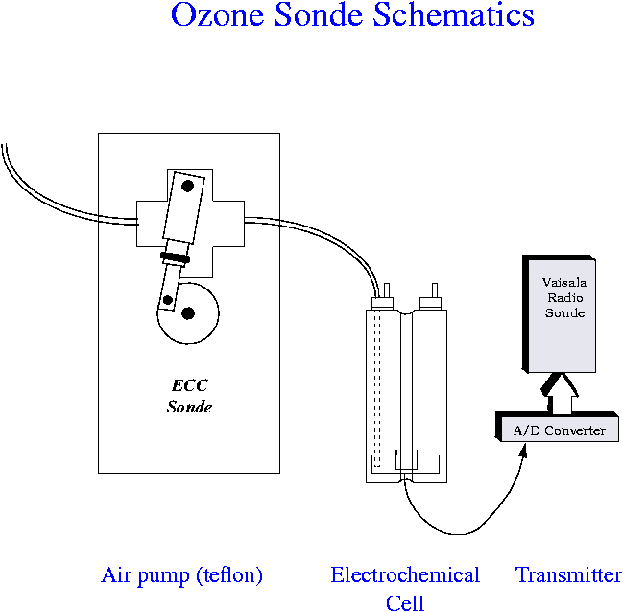
Ozone Profiles Using Electrochemical Concentration Cell (ECC) Ozonesondes
Ozone vertical profiles are
obtained using electrochemical concentration cell ozonesondes (ECC), a standard
technique for such measurements. The heart of the instrument is the
electrochemical cell that consists
of a cathode cell containing 3 ml of dilute KI solution, and an anode cell
containing 1.5 ml saturated KI (Figure 1). A Teflon piston pump forces ambient
air, containing ozone, into the cathode cell solution, which immediately
produces iodine. Current flows through the cell via an external circuit,
reducing the iodine back to iodide. The cell current is theoretically directly
proportional to the amount of ozone (one ozone molecule results in the flow of 2
electrons). Ozone partial pressure is then computed by the following equation:
Рozone = 4.307x10-4 (I IBG) Tpump T100
PCF
.
where
Рozone= Partial
pressure of ozone (millipascals).
4.307x10-4
=
Constant to convert current to ozone concentration.
I =
Cell current (microamps) ~ 5
μamps @ O3 peak in
stratosphere.
IBG = Cell
background current ~ < 0.03 μamps on zero O3 filter.
Tpump = Temperature of sonde pump (K).
T100 = Pump flow rate: seconds
per 100 cc.
PCF = Pump flow rate efficiency correction factor.
Several
recipes for the sensing solution are currently in use at various stations. In
addition there are also several pump efficiency correction factors (PCF) used.
The NOAA/CMDL ozonesondes (Trinidad Head, CA; Hilo, HI; and Cheju Island, Korea)
all use a 2% unbuffered KI solution and a PCF as described in Johnson et al.
(2001). The PCF is of importance for the stratospheric portion of the profile or
when integrating the profile to obtain a total column ozone amount.
Accuracy and precision of ±5% are achieved for ozone measurements in the
troposphere and stratosphere using the protocols described here.
The cell is mated through an electronics interface board to a standard meteorological radiosonde that telemeters data to a ground receiving station (Figure 1). The accompanying Vaisala radiosonde also provides temperature and tropospheric humidity information along with the ozone data. The instrument package weighing approximately 1 kg is flown on a meteorological balloon. The balloon size, designated by its weight, is usually 1200 or 1500 grams. The balloon normally achieves an altitude of 32 km and ascends at a nominal rate of 5 m/s. Depending on the system being used the data are obtained at a rate between 1 8 seconds. In TRACE-P data are obtained at 1-second intervals and for archival purposes are averaged into altitude increments of 100 meters.
Reference:
Johnson, B.J., S.J. Oltmans, H. Vφmel, T. Deshler, and C. Kroger, ECC ozonesonde pump efficiency measurements and tests on the sensitivity to ozone of buffered and unbuffered ECC sensor cathode solutions, J. Geophys. Res., accepted, 2001.

Figure 1: Schematic drawing showing the ozonesonde pump, electrochemical cell, and interfacing to the radiosonde.